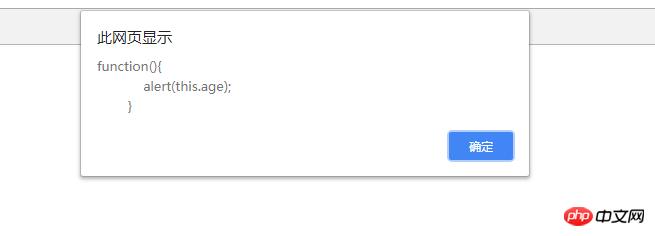JS 的面向对象中继承的那些小事(案例)
时间:2024/6/3作者:未知来源:争怎路由网人气:
- 网页的本质就是超级文本标记语言,通过结合使用其他的Web技术(如:脚本语言、公共网关接口、组件等),可以创造出功能强大的网页。因而,超级文本标记语言是万维网(Web)编程的基础,也就是说万维网是建立在超文本基础之上的。超级文本标记语言之所以称为超文本标记语言,是因为文本中包含了所谓“超级链接”点。本章给大家介绍JS 的面向对象中继承的那些小事(实例),让大家了解js中的继承特点是什么?面向对象中继承的一些小知识。有一定的参考价值,有需要的朋友可以参考一下,希望对你有所帮助。
JS中继承的特点:
1、子类继承父类;
2、子类可以用父类的方法和属性
3、子类的改变可以不影响父类
下面用一个例子来说明 JS 的继承
这段代码创建了一个父类以及它的原型,同时还创建了一个子类,并继承了父类的私有属性
<script> //这是父类 function Father(name,age,marry){ this.name=name; this.age=age; this.marry=marry; } //父类的原型 Father.prototype.showName=function(){ alert(this.name); } //子类 function Son(name,age,marry,weight){ Father.call(this,name,age,marry); this.weight=weight; } </script>当子类Son想继承父类的原型时,我的做法一开始是这么做的
<script> //这是父类 function Father(name,age,marry){ this.name=name; this.age=age; this.marry=marry; } //父类的原型 Father.prototype.showName=function(){ alert(this.name); } //子类 function Son(name,age,marry,weight){ Father.call(this,name,age,marry); this.weight=weight; } //错误的做法 Son.prototype=Father.prototype; Son.prototype.showAge=function(){ alert(this.age); } var father=new Father('王大锤',30,true); alert(father.showAge); </script>
运行的结果可以发现,子类原型的改变影响了父类的原型,父类的原型中本来是没有showAge方法的,这就违背了前面继承的第三个特点了。
分析原因:上面代码的第20行 Son.prototype=Father.prototype;这里的 '=' 两边都是对象,那么它代表的意思就是引用,如果是引用的话,左边的对象改变,肯定会影响了右边的对象。所以才出现了子类原型的改变影响了父类的原型。
解决办法
方法一:核心思路,前面的问题不是说 '=' 是引用的关系才导致问题的嘛,那这里就保证 '=' 永远是赋值的关系,而不是引用。这里就定义一个 Clone() 方法,将父类对象拷贝给子类。
Clone() 方法里用到递归的原因是,在拷贝的过程中对象中可能嵌套对象。
<script> //这是父类 function Father(name,age,marry){ this.name=name; this.age=age; this.marry=marry; } //父类的原型 Father.prototype.showName=function(){ alert(this.name); } //子类 function Son(name,age,marry,weight){ Father.call(this,name,age,marry); this.weight=weight; } Son.prototype=new Clone(Father.prototype); Son.prototype.showAge=function(){ alert(this.age); } var father=new Father('王大锤',30,true); alert(father.showAge); //通过克隆对象:核心思路是保证 '=' 是赋值的关系,而不是引用,也就是保证 '=' 的右边不是对象 function Clone(obj){ for(var i=0;i<obj.length;i++){ if(typeof(obj[key]=='object')){ this.key=new Clone(obj[key]); }else{ this.key=obj[key]; } } } </script>
方法二:代码很简单,但是很难想到,没有第一个方法那么好理解。核心思想:对象自身属性的改变,不会影响其构造函数的属性的改变。
<script> //这是父类 function Father(name,age,marry){ this.name=name; this.age=age; this.marry=marry; } //父类的原型 Father.prototype.showName=function(){ alert(this.name); } //子类 function Son(name,age,marry,weight){ Father.call(this,name,age,marry); this.weight=weight; } function fn(){} fn.prototype=Father.prototype; Son.prototype=new fn(); Son.prototype.showAge=function(){ alert(this.age); } var father=new Father('王大锤',30,true); alert(father.showAge); //通过克隆对象:核心思路是保证 '=' 是赋值的关系,而不是引用,也就是保证 '=' 的右边不是对象 // Son.prototype=new Clone(Father.prototype); // function Clone(obj){ // for(var i=0;i<obj.length;i++){ // if(typeof(obj[key]=='object')){ // this.key=new Clone(obj[key]); // }else{ // this.key=obj[key]; // } // } // } </script>
以上就是JS 的面向对象中继承的那些小事(实例)的详细内容,更多请关注php中文网其它相关文章!
网站建设是一个广义的术语,涵盖了许多不同的技能和学科中所使用的生产和维护的网站。
关键词:JS 的面向对象中继承的那些小事(案例)